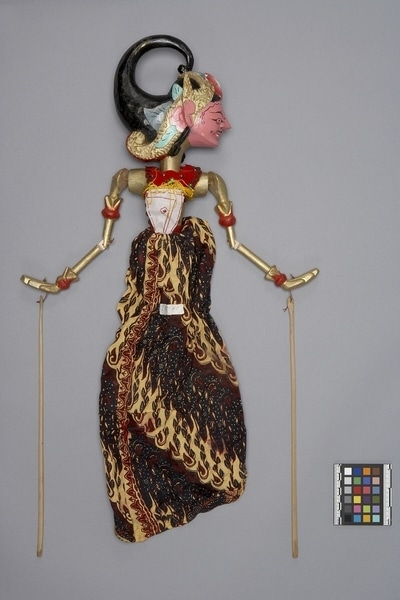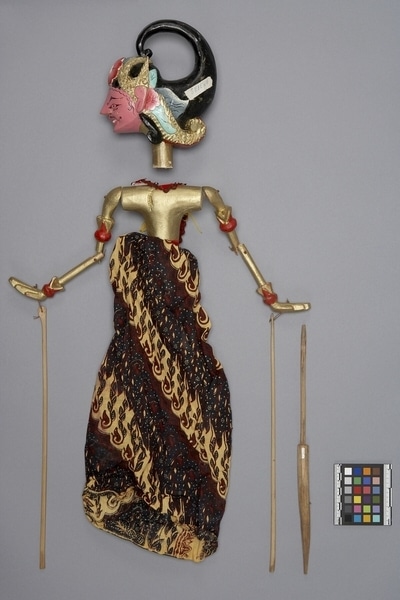Rod Puppet Item Number: Ib406 a-c from the MOA: University of British Columbia


Description
Three-dimensional male humanoid figure (part a) with large head (part b) and jointed arms attached to controlling rod (part c). Pink face with slightly curved pointed nose positioned forward with white teeth. Eyes outlined in black, cast forward. Hair, moustache, beards, other facial details on black. Long curved (gelung supit urang) headdress with very long sumping in gold with green dawala, two forward sumping around a flower motif at forehead. Single long black hair curl (kendit). Gold neck and upper torso; gold and red ornaments on each arm at bicep and wrist. Hands held flat and bent back at wrist. Red chest covering and apron with wavy brown trim, green sequins with bead centres. Apron has red waistband, yellow fringe at bottom. Long batik skirt (blue, purple, and beige). 'Sadewa' in blue ink on white lined paper glued to skirt front and headdress (to right).
History Of Use
Javanese puppetry as an art form probably developed by the 11th century. Wayang golek puppets of western Java appeared during the 16th century. Originally the plays depicted Javanese mythology, but after the Indian conquest of Java the Hindu epics, Ramayana and Mahabharata, were incorporated into the cycles, which comprise about 200 plays. A dalang (puppet master) performs the plays to celebrate important occasions, usually in three acts, with vocal and instrumental accompaniment. Typically they serve a moral and religious purpose, and more recently, one of political commentary. Sadewa is a prince from the Mahabharata cycle. He is associated with the Pandawa brothers, and is the twin brother of Nakula.
Cultural Context
Theatrical performance.
Iconographic Meaning
Each puppet is characterized by its wanda, a Javanese word which describes the specific mixture of elements of size, form, colour, ornamentation and carving. Colour and position of face suggest some virtue, although aggressiveness also implied. Facial features are not unrefined. Position of hands, arm ornaments, batik skirt, and headdress indicate nobility. Inscription correctly identifies puppet as Sadewa (or Nakula), kendit and slight beard only variations.
Item History
- Made in Java, Indonesia
- Owned by Donald Bone before January 4, 1980
- Received from Donald Bone (Seller) and Museum of Anthropology Donations Fund (Funding source) on January 4, 1980
What
- Name
- Rod Puppet
- Identification Number
- Ib406 a-c
- Type of Item
- puppet
- Material
- cotton fibre, paint, fibre and wood
- Manufacturing Technique
- carved, sewn, woven, painted and tied
- Part A
- height 6.0 cm, width 58.0 cm, depth 17.0 cm
- Part B
- height 22.0 cm, width 18.0 cm, depth 9.0 cm
- Part C
- height 34.5 cm, width 2.0 cm, depth 1.0 cm
Who
- Culture
- Sundanese
- Previous Owner
- Donald Bone
- Received from
- Donald Bone (Seller) and Museum of Anthropology Donations Fund (Funding source)
Where
- Holding Institution
- MOA: University of British Columbia
- Made in
- Java, Indonesia
When
- Ownership Date
- before January 4, 1980
- Acquisition Date
- on January 4, 1980
Other
- Condition
- fair
- Accession Number
- 0586/0026 a-c